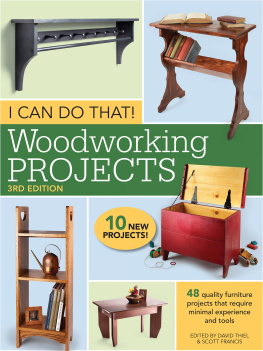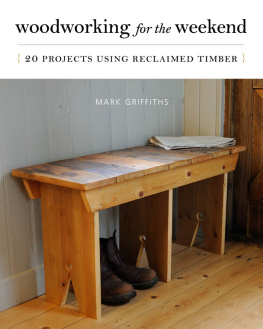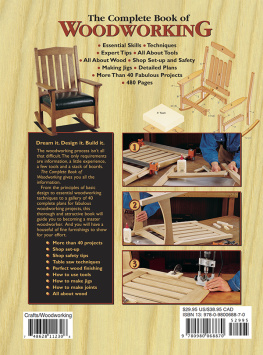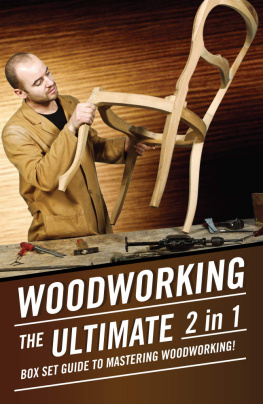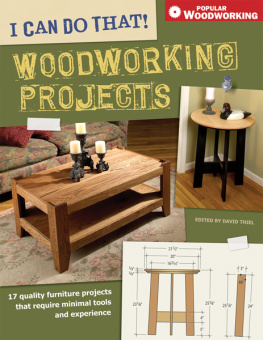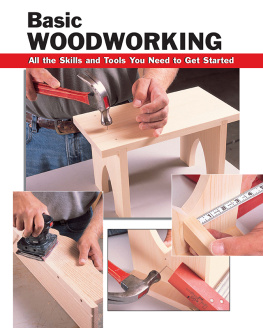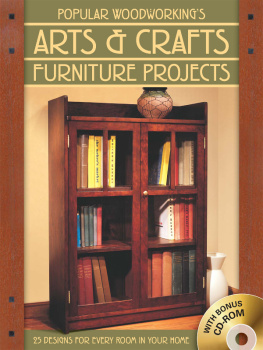

DEDICATION
To my wife Gilly, and my children Amy and Hunter.

First published in the United States of America in 2013 by Chronicle Books LLC.
Copyright 2013 by Ivy Press Limited.
All rights reserved. No part of this book may be reproduced in any form without written permission from the publisher.
ISBN: 978-1-4521-3192-4
The Library of Congress has previously cataloged this title under ISBN: 978-1-4521-2586-2
Text by Mark Griffiths
Designer Naomi MacDougall
Illustrations by Mark Hall-Patch & John Woodcock
Photography by Neal Grundy & Andrew Perris
The copyright holder would like to thank the Brighton & Hove Wood Recycling Project, the Secret Campsite, the Tin Tabernacle, and Sian and Chris Wilkings for their assistance with the photoshoot.
This book was conceived, designed, and produced by Ivy Press
210 High Street, Lewes
East Sussex BN7 2NS, UK
Chronicle Books LLC
680 Second Street
San Francisco, CA 94107
www.chroniclebooks.com

INTRODUCTION
MANY OF US SHARE A LOVE OF HANDICRAFTS. Even if we feel we personally have no creative talent ourselves, our appreciation of pieces handmade by others is evident in the countless craft stores and fairs across the country. Keeping this in mind, the aim of this book is to present woodworking projects that are achievable by anyone, whatever you think of your woodworking ability. Some of these projects will present their challenges, but working through them is guaranteed to bring you a warm glow of achievement as you stand back to look at the finished results. Nothing beats the sense of pride felt when sitting in a chair or eating from a table you have made yourself.
One of the main reasons we often hold back from unleashing the toolbox is simply the feeling of being out of his or her depth. When it comes to woodworking, just taking a trip to the local lumberyard for wood can be an intimidating experience for the beginner. As much as possible, the projects in this book have been developed to use found and reclaimed lumber, thereby bypassing the lumberyard manned by experts. And because the wood being used is inexpensiveor better yet, freetheres little need to worry about the cost of making mistakes. Also with the intention of keeping expenses down, the projects can also be assembled with a minimum of tools.
The projects I have created in this book have largely taken their form, design, and proportion from the salvaged materials available to me. In a similar fashion, the furniture you create will reflect the reclaimed lumber that you find. This is the beauty of working in this way: each item made is individual and unique to the maker.
Building custom-made and beautiful items for the yard is a great place to begin experimenting with woodworking. You are creating objects that are both practical and great to look atand that are one of a kind. Using the projects in this book, you will discover a whole new way of looking at and working with wood, and they may even unleash creative talents you didnt know you had. I like to think of the projects contained in this book as an outline or point of referencethey are simply a suggestion for what you can create from materials seen as worthless by others. My hope is that you will be inspired to create new designs and have new ideas as your confidence in making grows.
WHERE TO FIND THE WOOD
Its only when you start salvaging wood to make stuff, that you become aware of just how much useful material most people simply throw away. Finding inexpensive, or even free, lumber that will be great to work with is relatively easy. Here are a few pointers to get you started.
PREPARING YOUR SHOPPING LIST
Ive included lumber cutting guides for each project so you can see what I used, but you should adapt the lists to match the reclaimed lumber you find rather than trying to match my materials.
THE SEARCH BEGINS
When it comes to reclaiming wood for these projects, it often helps if you start by gradually building up a stock of items. Each time you happen to be near a yard sale, garage sale, junkyard, salvage center, or flea market, stop and rummage around if time permits. These are all great places to find a bargain, either to break apart for the wood, or convert and reimagine into something else that fits your needs. Even wood crates or pallets used for delivery can be turned into interesting woodworking projects.
It can be intimidating to knock at the door of a woodworking company, such as a carpentry or cabinetmaking workshop, but if you approach with a casual, friendly manner, you can strike up a relationship that may be a source for scrap wood, sheets of manufactured wood, and even advice.
If you have the confidence to visit woodworking workshops, the next step is to visit a construction site. This is a place rich in raw materials that would only be consigned to the Dumpster. Again, its the right approach that will yield the best rewards. There will be strict on-site health and safety rules, so dont just wander in. Instead, get the attention of whomever is in charge and talk to that person about what you need for your project.
Internet forums can help you to find sources for inexpensive lumber and tools for sale as well as people who can provide helpful advice.

In addition to being good for the environment, salvage centers selling reclaimed lumber offer a wide range of different types of wood in a variety of finishes.

Softwoods are relatively inexpensive and easy to work with, making them a popular choice for furniture, particularly when you are starting out.

Hardwoods are a viable choice for more experienced woodworkers who want to make a strong impression with their projects final finish.
Finally, put the word out to family, friends, and neighbors that you are in the market for odd scraps of wood and old furniture that they may no longer have any use for. You will be amazed at the number of people who have what they see as useless junk cluttering up their homes, which they will often gladly donate to your projects.
As a rule, I always have my breaking kita screwdriver, claw hammer, and handsawin the back of the pickup truck, because you never know when you may stumble upon a treasure trove of wood. At times, in fact, I think the search for materials is just as much fun as turning them into something useful.
UNDERSTANDING TYPES OF WOOD
Its a good idea to have a little knowledge about the types of wood before setting out on the hunt. Solid wood is categorized as either softwood or hardwood. Generally, softwood is produced by fast-growing coniferous, or cone-bearing, evergreen trees, such as cedar, Douglas fir, pine, and redwood. It tends to be less stable than hardwoodmore prone to movementwhen passed through the sawmill and during project making. Typically, there is a greater proportion of knots in softwood than hardwood, and the resinous grain structure of softwood makes it less able to take an even wood stain finish. In its favor, it is easy to work and, with the exception of redwood, inexpensive.
Next page







